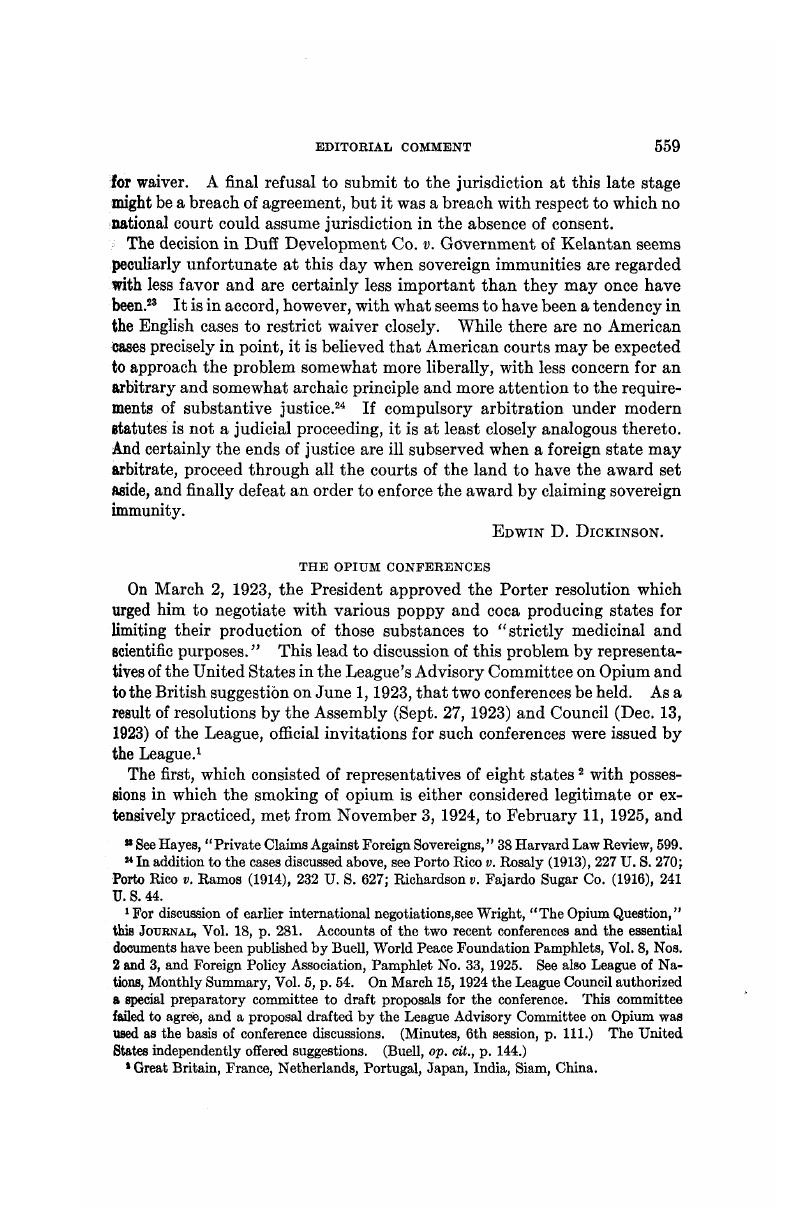No CrossRef data available.

1 For discussion of earlier international negotiations,see Wright, “The Opium Question,” this Journal, vol. 18, p. 281.Google ScholarAccounts of the two recent conferences and the essential documents have been published by Buell, World Peace Foundation Pamphlets, vol. 8, Nos. 2 and 3, and Foreign Policy Association, Pamphlet No. 33, 1925.Google ScholarSee also League of Nations, Monthly Summary, vol. 5, p. 54.Google Scholar On March 15, 1924 the League Council authorized a special preparatory committee to draft proposals for the conference. This committee failed to agree, and a proposal drafted by the League Advisory Committee on Opium was used as the basis of conference discussions. (Minutes, 6th session, p. 111.) The United States independently offered suggestions. (Buell, op. cit., p. 144.)Google Scholar
2 Great Britain, France, Netherlands, Portugal, Japan, India, Siam, China.
3 This contained a resolution and reservations by Great Britain, Portugal, and Siam.
4 Albania, Germany, United States, Australia, Belgium, Bolivia, Brazil, British Empire, Bulgaria, Canada, Chiles China, Cuba, Denmark, Free City of Danzig, Dominican Republic, Egypt, Spain, Finland, France, Greece, Hungary, India, Irish Free State, Italy, Japan, Luxemburg, Netherlands, Nicaragua, Persia, Poland, Portugal, Roumania, Kingdom of Serbs, Croats and Slovenes, Siam, Sweden, Switzerland, Czechoslovakia, Turkey, Uruguay, Venezuela.
5 This contained seven resolutions and reservations by Persia and Siam.
6 The superior results already obtained and the suspicion that the participating Powers were really “seeking to promote their commercial interests and to earn business profits for themselves” were the reasons given by the Soviet government. Letter and memorandum, October 29, 1924, O.D.C. 4.
7 This Journal, vol. 19, p. 380, and comment, ibid., p. 348.
8 U. S. memorandum on withdrawal, supra, note 7;Google Scholarconcluding remarks of Zahle, M., of Denmark, president of the conference, Minutes 38th Plenary meetings, printed in Foreign Policy Association pamphlet, op. cit., pp. 18–22;Google ScholarBuell, op. cit, p. 116;Google ScholarForeign Policy Association pamphlet, op. cit, p. 16.Google Scholar
9 Ibid.
10 Foreign Affairs, vol. 3, p. 356, April, 1925.Google Scholar
11 Conference Internationale de I'Opium, La Haye, 1912, Proces-Verbaux officiels, p. 244.Google Scholar
12 Supra, note 7.
13 Ibid., 8.
14 The principles and the agenda were fixed by the Assembly and Council resolution calling the conferences, and more specifically by the preparatory committee. See League of Nations Official Journal, April, 1924, p. 523;Google ScholarBuell, op. cit., pp. 83–86.Google Scholar
15 Minutes 26th meeting, February 7, 1925.Google ScholarSee also this Journal, vol. 19, pp. 350–354.Google Scholar
16 Minority report of Surgeon General Blue of United States, sub-committee F., O. D. C. 73, and Polish proposal, O. D. C. 62. See also Opium Committee, 5th session, Minutes, pp. 68–72.Google Scholar
17 See discussion in 6th meeting, League Opium Committee, Minutes, pp. 56–58.Google Scholar
18 As China.
19 See Buell, op. cit., pp. 47–53.Google Scholar
20 See translation of Belgrader Zeitung, February 27, 1925, printed in Buell, op. cit., p. 108.Google Scholar
21 O.D.C., 34; Buell, op. cit., p. 145.Google Scholar
22 See remarks of M. Loudon, of the Netherlands, Minutes 26th plenary meeting, February 7, 1925.
22a For activities of the International Narcotic Education Association, see remarks of Representative Lineberger of California, reproducing an article by Capt. Richmond P. Hobson, Cong. Record, Feb. 18, 1925. For activities of the International Anti-Opium Association of Peking, see War Against Opium, Tientsin, 1922.
23 A resolution of the first conference somewhat equivocally endorsed the license-rationing system.
24 Buell, op. cit., pp. 58–64.Google Scholar
25 Statement of Bishop Brent, Opium Committee, 5th Session, Minutes, p. 52.Google Scholar
26 Wright, this Journal, vol. 18, p. 293;Google ScholarBuell, op. cit., pp. 42–45.Google Scholar Eating of coca leaves is also defended by the Bolivian Government, ibid.
27 The British Government has always considered the regulation of “excise” opium as a domestic question. See instructions for British delegation, 1912, Cd. 6605 (1913), p. 3.Google Scholar It is now under the control of the native Indian provincial legislatures. Buell, op. cit., p. 45.Google Scholar
28 Text printed by Buell, op. cit., pp. 159–165.Google Scholar
29 Minutes, 19th Plenary meeting.
30 Minutes, 20th Plenary meeting.
31 Minutes, 11th Plenary meeting.
32 League of Nations, Advisory Committee on Opium, 6th meeting, Minutes, p. 40.Google Scholar